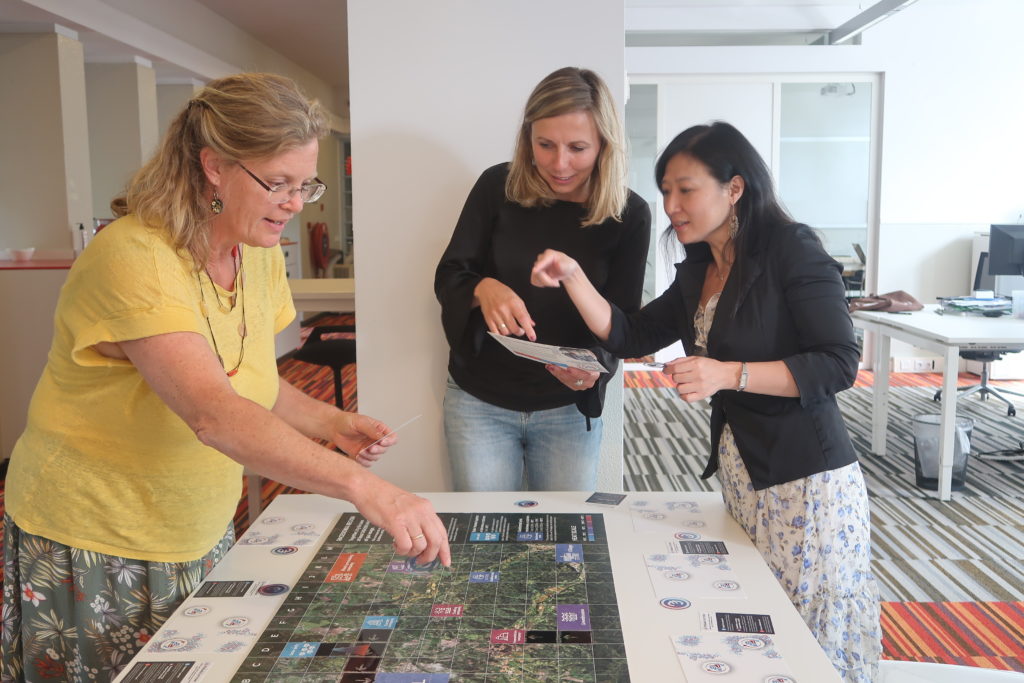HEATOPOLY IS A SERIOUS GAME ABOUT CLIMATE AND HOW TO REDUCE CO2 EMISSIONS WHILE STILL THRIVING AS AN INDUSTRIAL HUB.
The role-play board game aiming to tackle CO2 emissions
The city of R-ACEDONIA is like many others. Beautiful rivers and nature surround this growing industrial hub. The citizens are happy to see that investment in their area has led to growth. But with growth has come challenges. Citizens are concerned about the carbon footprint and environmental impact of the industrial sector; the energy bills are skyrocketing throughout the whole area. The government is demanding local action to help meet the national climate targets. Together people from all over the city band together to work out how to reduce their CO2 emissions while still thriving as an industrial hub.
This is the premise of new emission-fighting board game HEATopoly. The brainchild of R-ACES, an EU-funded project that is researching how to help turn industrial parks into eco-regions by reducing their CO2 emissions by at least 10%. The aim of the citizens of R-ACEDONIA mirrors that of R-ACES(though you might have guessed by the similarity in names!). Both the game and project have three tasks to meet this target : exchanging surplus energy, using renewables, and creating a smart management system for clusters of companies.
Speaking to the main designer of Heatopoly, Lotte van der Velde, she simplifies the core process that will reduce CO2 emissions both in R-ACEDONIA and real life: “building pipelines in between the different companies so that residual heat can be transported from one company to the other”. One of the main issues according to van der Velde was that “not all industrial partners are aware of what energy cooperation is,” therefore creating an opportunity for education and thus Heatopoly was born.
The game exists in an online and physical format. Taking between 6-12 players, it is split up into two parts. Part A takes about 90 minutes and focuses on establishing energy cooperation projects and investing in renewable energy sources. Each player is a predetermined stakeholder in R-ACEDONIA, with the aim of collaborating in order to build heat networks to share heating and cooling among buildings. Additionally, players have a personal mission that they need to fulfil, one that may or may not be hindered by the main objective – providing an in-game example of real-life conflict of interest.
Part B takes about 45 minutes and is used to reflect on the decisions made throughout the game, both individual and collective. Motives and intentions are at the forefront of this discussion. The online component is played in an environment called Mural which does not have video conferencing capability, so another app like Zoom, Skype or Meet would need to be used alongside it. It also includes an Excel spreadsheet for keeping score and a PowerPoint presentation introducing the idea of energy cooperation.

Heatopoly is one of a new set of emerging sub-genres of board games called “serious games”. Serious games differ from traditional games in that their main purpose is education rather than entertainment. The genius of Heatopoly lies in educating about “the interdisciplinarity of environmental issues; legal, economic, social and technological aspects are included in the game” according to van der Velde.
Heatopoly aims “to raise awareness and provide a basic understanding of energy cooperation”, according to the report R-ACES produced on the project. The target audience for this is business park leaders, policymakers, students and energy professionals. They also hope that it could be used as a training and educational tool in higher education institutions. R-ACES has identified industrial areas that could be turned into ecoregions in the Netherlands, Denmark, Belgium, and Italy.
Charlotte Lundsberg Baumgartner, project manager of Energy Cluster Denmark, an R-ACES partner, has done an online workshop showing people how to play the game but has come across a problem that mirrors the problem in the real world when trying to organise actual games: it was hard to get enough people to play. While it’s undoubtedly a great resource, “the game requires quite a high number of minimum players, which in a learning set up (university or school) would not be a problem, whereas in the municipalities and industry there is no time for this” she says reflecting on one of the biggest hurdles. She thinks the biggest strength of the game is that it can be “a good way to highlight some of the barriers as well as the conflicts that can arise” in the real world, teaching the participants how to cooperate even when they have different interests.
So, what prompted R-ACES to create a board game that was centred around reducing CO2 emissions at industrial parks? Research shows that the industry sector represents 25% of all energy demand and 50% of total cooling and heating demand in Europe. Currently only 20% of that energy comes from renewables. Further research showed that people learn better through experiential methods rather than traditional information-based methods. The goal of this project was to get stakeholders together in what they call “learning communities” to play this game during their meetings so they could see the real-world options and consequences of particular actions.
For those interested in playing the game, contact the Institute for Sustainable Process Technology (ISPT)
The article was published onlin on the Boardgame News website.